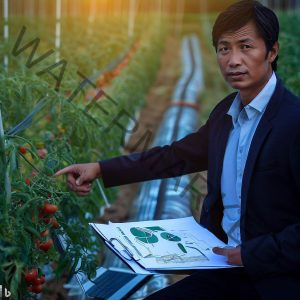Tomato farming is an excellent venture for individuals interested in agriculture and seeking a profitable business opportunity. This article aims to provide a comprehensive business plan for tomato farming, covering various aspects from market analysis to production techniques.
Whether you are a novice or an experienced farmer, this guide will equip you with the necessary knowledge to establish a successful tomato farming business.
[Pdf Sample] Tomato Farming Business Plan Proposal Docx
To write a business plan, here is a breakdown of how it should be structured and what should be in each category. After this instruction, I will provide you with a sample of one I wrote for my farm, let us go:

Executive Summary
The executive summary provides a brief overview of the tomato farming business plan, highlighting key points such as the market potential, target audience, and financial projections. It serves as a snapshot of the entire plan, giving readers a glimpse into the business’s objectives and strategies.
Read Also: [Pdf Sample] Business Plan For Potato Farming Docx
Market Analysis
In this section, we delve into the market analysis of the tomato farming industry. We explore the demand and supply dynamics, market trends, competition, and potential customers. Understanding the market is crucial for identifying target markets, developing pricing strategies, and positioning your tomato products effectively.
Choosing the Right Tomato Varieties
The choice of tomato varieties significantly impacts the success of your farming business. We discuss the various types of tomatoes, including determinate and indeterminate varieties, heirloom tomatoes, cherry tomatoes, and hybrid varieties. Evaluating the characteristics and market demand for different varieties will assist you in making informed decisions when selecting the appropriate tomatoes to cultivate.
Read Also: [Pdf Sample] Business Plan For Cabbage Farming Docx
Land and Infrastructure Requirements
To establish a tomato farming business, suitable land and infrastructure are essential. This section provides insights into the land requirements, soil quality, and environmental factors necessary for optimum tomato production. Additionally, we discuss the infrastructure needed, such as greenhouses, irrigation systems, storage facilities, and packing houses.
Preparing the Soil for Tomato Farming
Preparing the soil is a critical step in tomato farming. We outline the techniques and best practices for soil preparation, including soil testing, soil amendments, and organic matter enrichment. By following these guidelines, you can create a nutrient-rich and well-drained soil environment, ensuring healthy tomato plants and abundant yields.
Read Also: [Pdf Sample] Business Plan For Tomato Greenhouse Docx
Seedling Production
High-quality seedlings are vital for a successful tomato farming business. This section covers the techniques for seed selection, seed treatment, and seedling production. We discuss seedling trays, growing media, temperature and light requirements, and transplanting methods. Producing robust and disease-resistant seedlings sets the foundation for a productive tomato crop.
Planting and Crop Management
Proper planting and crop management techniques are crucial for maximizing tomato yields. We provide step-by-step guidance on planting procedures, including spacing, depth, and plant support systems. Additionally, we explore essential crop management practices such as pruning, staking, and trellising, which contribute to improved plant health and productivity.
Read Also: [Pdf Sample] Business Plan For Vegetable Farming Docx
Irrigation and Water Management
Tomatoes require adequate water for optimal growth and fruit development. This section emphasizes the importance of efficient irrigation and water management practices. We discuss various irrigation methods, water scheduling, moisture monitoring, and water conservation techniques. By implementing proper irrigation strategies, you can prevent water stress and achieve consistent crop yields.
Fertilizer and Nutrient Management
Nutrient management plays a significant role in tomato farming. We delve into the essential nutrients required for tomato plants and discuss fertilizer application techniques, soil testing, and nutrient deficiencies. By maintaining proper nutrient levels, you can enhance plant health, fruit quality, and overall productivity.
Read Also: [Pdf Sample] Business Plan Guide For Strawberry Farming Docx
Pest and Disease Control
Pests and diseases pose significant challenges in tomato farming. We explore common pests and diseases affecting tomatoes, their identification, and effective control measures. Integrated Pest Management (IPM) strategies and organic pest control methods are also discussed to minimize chemical usage and promote sustainable farming practices.
Harvesting and Post-Harvest Handling
Knowing when and how to harvest tomatoes is crucial for preserving their quality and market value. We provide guidelines for determining the right harvesting time and proper harvesting techniques. Additionally, we cover post-harvest handling practices, including grading, packaging, storage, and transportation, to ensure that your tomatoes reach the market in optimal condition.
Read Also: [Pdf Sample] Business Plan For Bell Pepper Farming Docx
Marketing and Sales Strategies
To succeed in the tomato farming business, effective marketing and sales strategies are vital. This section explores various marketing channels, including local markets, supermarkets, restaurants, and online platforms. We discuss branding, product differentiation, pricing strategies, and customer relationship management to help you create a strong market presence.
Financial Planning and Budgeting
Sound financial planning is essential for the long-term sustainability of your tomato farming business. We guide you through the process of creating a comprehensive financial plan, including startup costs, operational expenses, revenue projections, and profitability analysis. Developing a realistic budget will enable you to make informed financial decisions and monitor the financial performance of your business.
Read Also: [Pdf Sample] Business Plan For Small Vegetable Farming Docx
Risk Assessment and Mitigation
Every business faces risks, and tomato farming is no exception. In this section, we identify potential risks and challenges associated with tomato farming and provide strategies for risk mitigation. By understanding and proactively managing risks, you can safeguard your business and ensure its resilience in the face of adversity.
Here Is The Download Link To Business Plan Proposal For Tomatoes Farming By Agrolearner
Business Model: Agrolearner.com’s Tomato Farming Business
Value Proposition:
Agrolearner.com Farm aims to provide high-quality, locally grown tomatoes to meet the increasing demand in the market.
We offer a wide variety of tomato options, including organic and specialty varieties, to cater to diverse customer preferences.
Our commitment to sustainable farming practices ensures the production of safe and environmentally friendly tomatoes.
Agrolearner.com Farm provides customers with reliable and consistent tomato supply, meeting their needs for both fresh consumption and processed products.
Customer Segments:
Retail grocery stores and supermarkets seeking a local and reliable source of fresh tomatoes.
Restaurants, hotels, and food service providers in need of high-quality tomatoes for their culinary offerings.
Individual consumers looking for locally grown and organic tomatoes.
Tomato processing companies requiring a consistent supply of tomatoes for their products.
Key Activities:
Tomato cultivation using modern farming techniques and sustainable practices.
Seedling production to ensure a consistent supply of healthy tomato plants.
Crop management, including planting, irrigation, fertilization, pest and disease control, and harvesting.
Post-harvest handling, sorting, grading, packaging, and storage of tomatoes.
Marketing and sales activities to promote and distribute tomatoes to target customers.
Key Resources:
Agricultural land suitable for tomato cultivation.
Infrastructure, including greenhouses, irrigation systems, storage facilities, and processing units.
Skilled labor and experienced farming team.
Quality seeds and seedlings.
Access to reliable water sources.
Technology for monitoring and optimizing farming operations.
Marketing and branding resources to establish a strong market presence.
Channels:
Direct sales to retail grocery stores, supermarkets, and processing companies.
Online sales through Agrolearner.com’s website and social media platforms.
Collaboration with local distributors for wider market reach.
Participation in farmers’ markets and community events for direct consumer engagement.
Customer Relationships:
Building long-term relationships with customers through consistent product quality and reliability.
Providing excellent customer service and support.
Engaging customers through educational content, newsletters, and social media interactions.
Gathering feedback and continuously improving our offerings based on customer preferences and market demands.
Revenue Streams:
Revenue primarily generated from the sale of tomatoes to retail stores, restaurants, hotels, and processing companies.
Additional revenue from online sales and direct-to-consumer channels.
Opportunities for revenue diversification through value-added products such as processed tomato sauces, canned tomatoes, and dried tomatoes.
Cost Structure:
Land acquisition or lease costs.
Infrastructure development and maintenance expenses.
Labor costs for farming operations, seedling production, and post-harvest handling.
Seed and fertilizer expenses.
Marketing and advertising costs.
Administrative and overhead expenses.
Quality control and certification expenses.
Ongoing research and development investment.
Key Partnerships:
Seed suppliers for sourcing high-quality tomato seeds.
Agricultural experts and consultants for guidance on best farming practices.
Distributors and wholesalers for wider market reach.
Local farmers’ associations and industry organizations for knowledge sharing and networking opportunities.
Financial institutions for potential funding and investment opportunities.
Technology providers for farm management and monitoring tools.
Key Metrics:
Sales revenue and profit margin.
Market share and customer retention rates.
Customer satisfaction and feedback.
Yield per acre and production efficiency.
Cost of production and overhead expenses.
Return on investment and financial sustainability.
By implementing this business model, Agrolearner.com’s Tomato Farming Business aims to create a successful and sustainable operation, meeting the demands of customers, contributing to the local agricultural industry, and generating profitable returns.
How much land do I need to start a tomato farming business?
The land requirement depends on the scale of your operation, but typically, you can start with a few acres of land for commercial tomato farming.
Which tomato varieties are popular in the market?
Popular tomato varieties in the market include beefsteak tomatoes, Roma tomatoes, cherry tomatoes, and heirloom varieties.
How do I control pests and diseases in tomato farming without excessive chemical use?
Integrated Pest Management (IPM) practices, including biological controls, crop rotation, and resistant varieties, can help minimize chemical usage while effectively managing pests and diseases.
What is the average yield of tomatoes per acre?
Tomato yield per acre can vary depending on various factors, but with proper management, you can aim for an average yield of 20-30 tons per acre.
How can I market my tomatoes effectively?
Effective marketing strategies for tomatoes include building relationships with local markets, exploring online platforms, ensuring product quality, and leveraging social media for promotion.
Conclusion:
Agrolearner.com Farm is well-positioned to become a leading player in the tomato farming industry. Through our commitment to implementing modern farming techniques, leveraging technology, and prioritizing sustainability, we are confident in our ability to deliver high-quality tomatoes and meet the growing demand in the market.
With careful planning, diligent execution, and a customer-centric approach, Agrolearner.com Farm aims to achieve long-term success and contribute to the agricultural sector’s growth.



